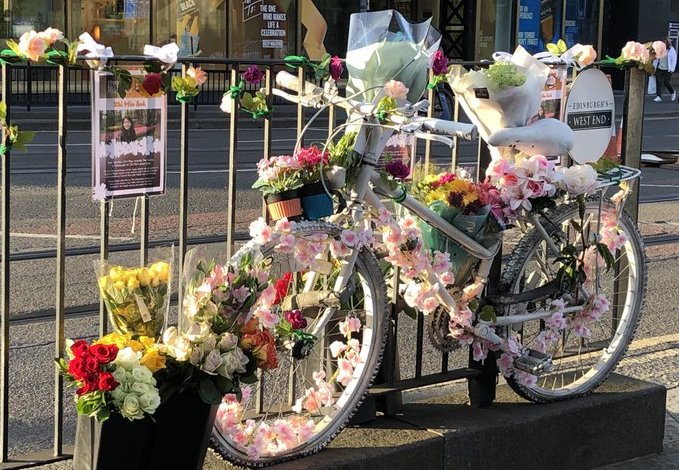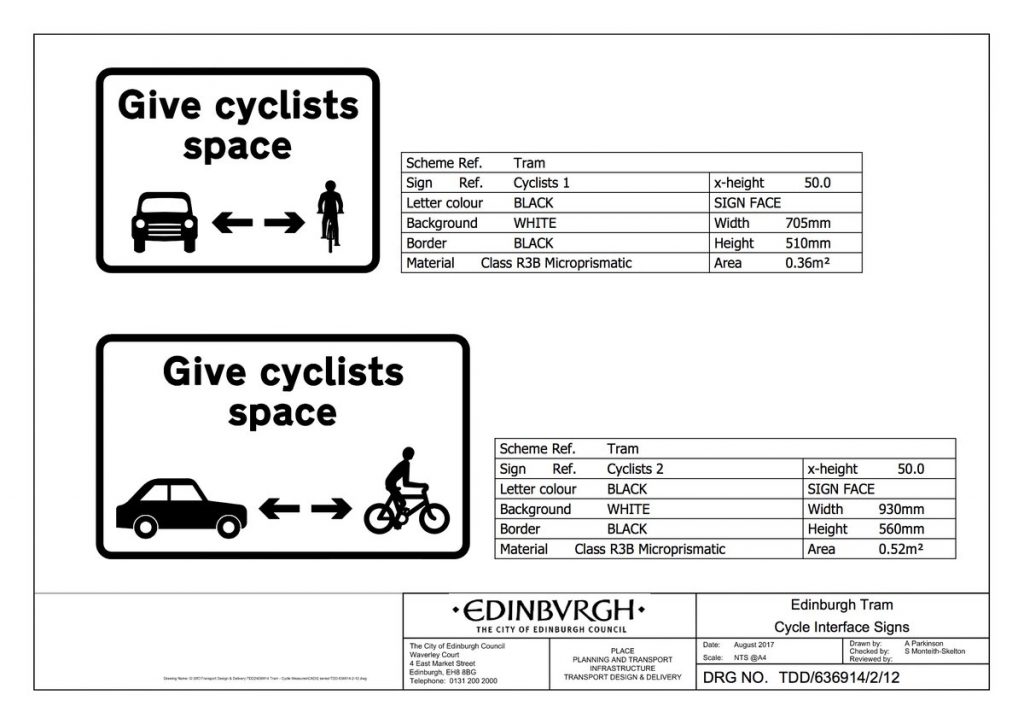May 31st marked 5 years exactly since the tragic death of student Zhi Min Soh, run over by a Rabbie’s bus after falling on the tramlines at the West End. @Infrasisters marked the event with a moving tribute attended by over 100 people, at the site of Zhi Min’s ghost bike.
It was also an opportunity to summarise what the Council has done to try and mitigate tramline dangers – and what still needs doing if tramline safety is to play its part in the Council’s Vision Zero ambition.

The memorial event timeline …
- Paradise by Coldplay – one of Zhi Min’s favourite songs
- Hayley Weetman from Infrasisters: speech notes – why this event matters
- Dave du Feu from Spokes: speech notes – tramline safety developments & issues
- One minute silence in memory of Zhi Min
- Pipes and Drum – by Mike the Piper, Mike Turpie, and his son Magnus
- Laying of Flowers on the ghost bike and the fence
More about the memorial event ..
- Edinburgh Reporter report
- Edinburgh Live report
- Evening News report
- Infrasisters advance press release
- Spokes member advance circular
- Selected tweets & videos from the event: 1 2 3 4 5 6 7

Tramline safety
- Countless people on bikes have come off on the tramlines
- Between 2009 and 2016 nearly 200 victims were hurt badly enough to attend A&E
- By 2015, nearly 100 victims had contacted Thompsons Solicitors alone
- In a test case brought by Thompsons Solicitors, Lady Wolffe at the Court of Session in 2019 awarded damages to 2 victims, stating that the road layout and tramtracks design were to blame, creating a “hazard” which posed a “significant risk of accident.” More on this in para 1906 here.
- When the original tramline layout was being devised, Spokes unsuccessfully urged safer layouts, such as the tramlines on one side of Princes Street and a segregated cycleroute on the other side, or other means of keeping cyclists and tramlines apart wherever possible. We even brought over a Dutch expert who did a brief report on layout options for Princes Street and for Leith Walk.
- Given that bikes are, with little other option. using the tramlined streets, we have identified two main causes of the bike/tramline crashes…
- (a) Blackspots where crossing the tramlines at a non-optimal angle is hard to avoid. In most cases, road layout changes could improve things – and at least some are in the pipeline (see below)
- (b) Traffic pressures, which can happen anywhere, forcing the cyclist into tramlines at a bad angle – including many cases where the cyclist is travelling parallel to the lines, not needing to cross them. This is much more difficult to tackle as widespread motorist awareness is very difficult to achieve – but if the Council sticks to its intention to reduce traffic, particularly in the city centre, this could make a big difference.
What has been done so far?
- Tramline bike crashes began as soon as tramlined roads were opened
- A frequently abused taxi rank at Haymarket, when tramlines opened in 2013, forced cyclists into the tramlines, causing multiple crashes. It was relocated but only after several weeks and many crashes
- In October 2017, prompted by the death of Zhi Min Soh, the continuing toll of crashes, and the inescapable evidence-based research from surgeon Prof Chris Oliver and from Thompsons and other Legal firms, the Council produced a 4-stage programme of remedial measures. Whilst these could not solve the basic problem of poor tramline layout design, they should certainly reduce the frequency of crashes. However, the timescales for parts of phase 2 and much of phases 3 and 4, proved wildly optimistic, with much of this still not in place as at June 2022. Measures included, from the simpler to the more complex…
- Give Cyclists Space signs. These signs were designed specially, given the evidence that traffic pressures contribute to many crashes, and had to get Scottish Government and UK permission before they could be erected, a lengthy process

- ‘Give cyclists space‘ publicity campaigns e.g. on the back of buses
- Red surfacing at recommended crossing points – to increase driver as well as cyclist awareness (this has negatives as well as positives)
- Advance cycle traffic lights at junctions associated with tramlines
- Changes in road layouts at blackspots. Most of the plans, described in a ‘Phase 3‘ document in May 2018, are still not in place – but all except the West End junction are now expected in autumn 2022
- Lothian Buses have done significant cyclist awareness training and several tramline victims have told us they were saved from worse injury by a vigilant Lothian Buses driver
- The tramline extension to Leith has learned some lessons, by providing segregated bike facilities on Leith Walk and an alternative route beyond Foot of the Walk [para 1809]. Distressingly, however, detailed design of the Leith Walk cycleroute has left much to be desired – and beyond Foot of the Walk cyclists will still be faced with tramlined roads where the alternative route does not fit their destination.
- Tramline crashes and injuries (some serious) continue, though not as frequently as at the outset. The improvement may reflect the above safety measures, or familiarity with the tramlines (by local cyclists, not visitors) or avoiding the area by bike, or probably a combination
What still needs doing
- The significant ‘phase 3’ road layout changes at South St Andrew St, South Charlotte St and Haymarket/ Grosvenor St junction are at last scheduled for work to begin – on September 5th, immediately after the Festival. In addition to Covid delays, there had been difficulty finding a willing contractor, at a reasonable price, with most work to be done at night when trams are not running.
- Phase 3 works at Haymarket Station and Haymarket Yards have been transferred into the CCWEL (city centre west-east route) on which construction has now started. Unfortunately the Haymarket Yards changes will not solve the main issue of the narrow section between tramline and kerb, where there have been serious injuries.
- The West End junction was recognised in the Council’s 2017 4-stage safety programme as a further blackspot, with several dangerous bike manoeuvres, but with its complexity and the amount of traffic, there was no obvious solution other than a complete redesign, ideally with reduced traffic, and no timescale was put on this. Spokes suggested an interim partial solution [page 3] which would also benefit pedestrians, but this was not taken up.
- In 2019 the West End junction redesign intention was incorporated into the City Centre Transformation policy, with work intended for the 2019-2022 period. That did not happen, and most recently it has been incorporated into the Transformation’s proposal for a pedestrian and cycle-friendly ‘Lothian Road Boulevard,’ intended for the 2023-2025 period. The design will clearly depend on how far the Council intends to limit the amount of motor traffic on this route, which is not yet known. However, we understand that the Council has applied to Sustrans for funding for the Boulevard design, including both the West End and Tollcross junctions.
- Although the above are all somewhere in the pipeline, more is needed…
- A segregated bike lane in Princes Street would keep bikes and tramlines separate, avoiding many crashes, and would encourage people scared of the tramlines to return to Princes Street
- In pursuing its Transformation policy, the Council should particularly emphasise traffic reduction in all tramline areas, given that traffic pressures contribute to many tramline crashes.
What you can do
- Keep reminding your councillors what needs done and how the tramlines affect you. Find your councillors here. Now is a particularly important and urgent time, with a new Council administration and many new councillors who may not be aware of the dangers or the background. Moreover, a new administration could change policies and even scrap or postpone the Lothian Road Boulevard project – or it could speed it up and end the delays we have seen!
- Retweet our tweet of this article.
